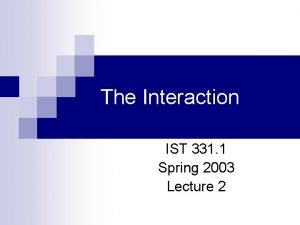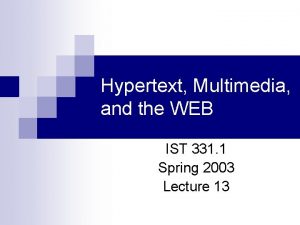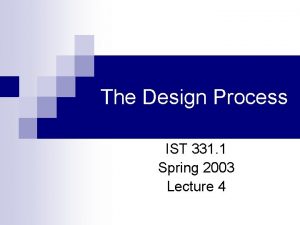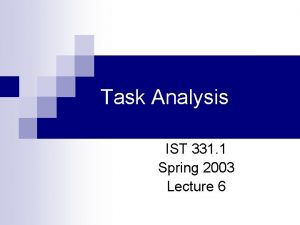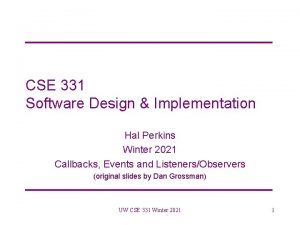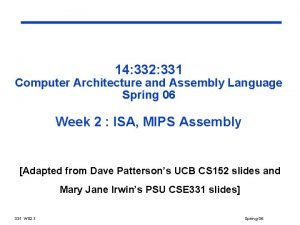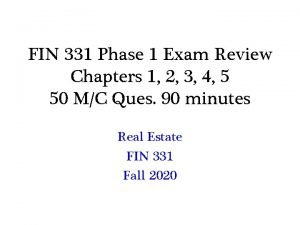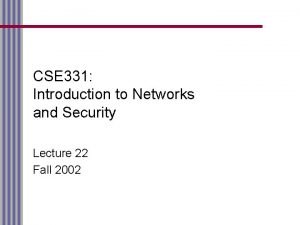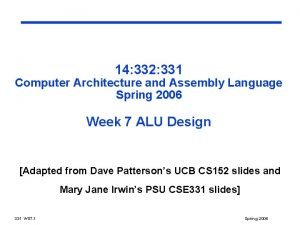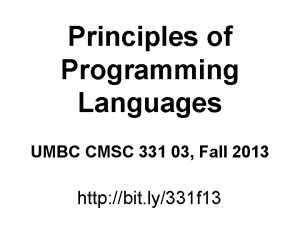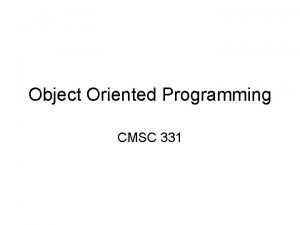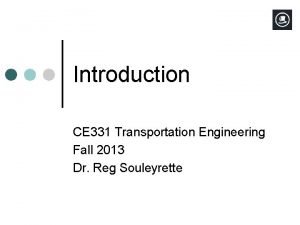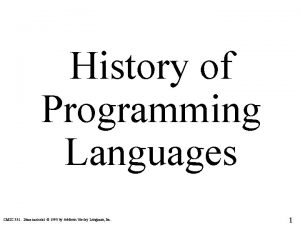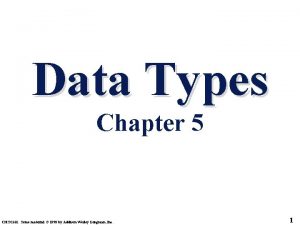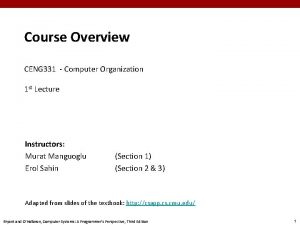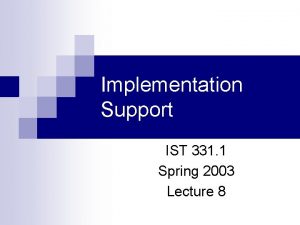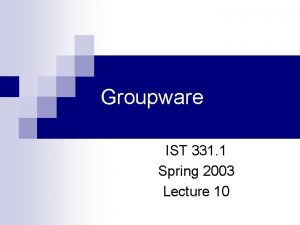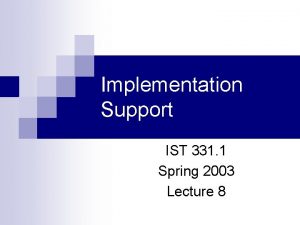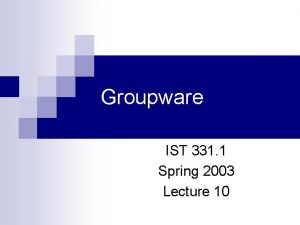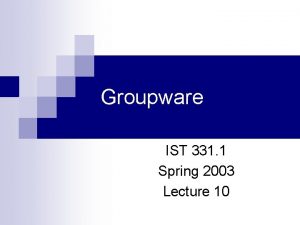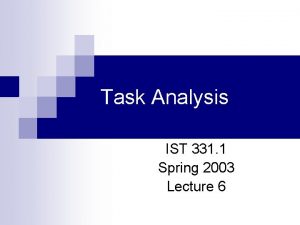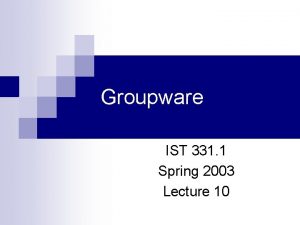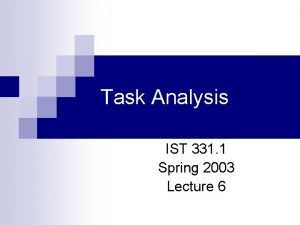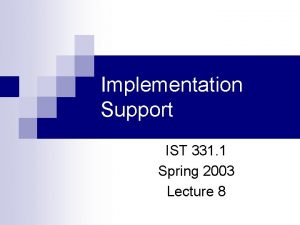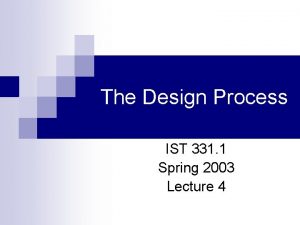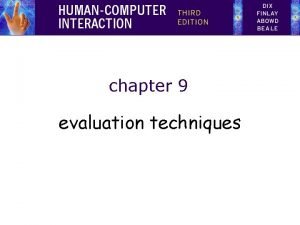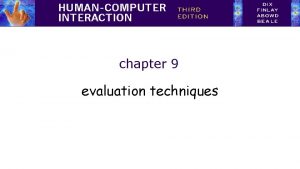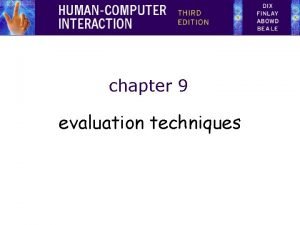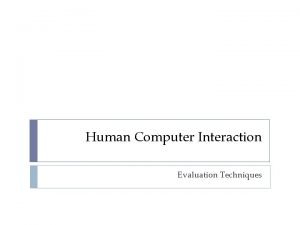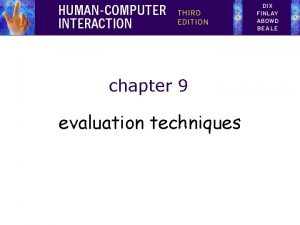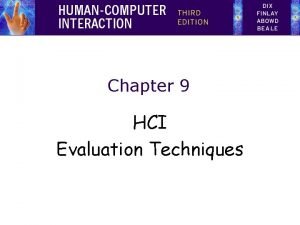Evaluation Techniques IST 331 1 Spring 2003 Lecture

























- Slides: 25

Evaluation Techniques IST 331. 1 Spring 2003 Lecture 9

Evaluation Techniques n Evaluation ¨ tests usability and functionality of system ¨ occurs in laboratory, field and/or in collaboration with users ¨ evaluates ¨ should cycle both design and implementation be considered at all stages in the design life

Goals of Evaluation assess extent of system functionality assess effect of interface on user identify specific problems

Laboratory studies Advantages: specialist equipment available uninterrupted environment Disadvantages: lack of context difficult to observe several users cooperating Appropriate if system location is dangerous or impractical for constrained single user systems to allow controlled manipulation of use.

Field Studies Advantages: natural environment context retained (though observation may alter it) longitudinal studies possible Disadvantages: distractions noise Appropriate where context is crucial for longitudinal studies

Participatory Design User is an active member of the design team. Characteristics context and work oriented rather than system oriented collaborative Iterative Methods brain-storming storyboarding workshops pencil and paper exercises

Evaluating the Design Cognitive walk-through n Heuristic evaluation n Review-based evaluation n Use of models n

Cognitive Walkthrough Proposed by Polson et al. • evaluates design on how well it supports user in learning task • usually performed by expert in cognitive psychology • expert `walks through' design to identify potential problems using psychological principles • forms used to guide analysis

Cognitive Walkthrough For each task walkthrough considers • what impact will interaction have on user? • what cognitive processes are required? • what learning problems may occur? Analysis focuses on goals and knowledge: does the design lead the user to generate the correct goals?

Heuristic Evaluation Proposed by Nielsen and Molich. usability criteria (heuristics) are identified design examined by experts to see if these are violated Example heuristics visibility of system status user control and freedom error prevention Heuristic evaluation `debugs' design.

Review-Based Evaluation Results from the literature used to support or refute parts of design. Care needed to ensure results are transferable to new design. Model-based evaluation Cognitive models used to filter design options e. g. GOMS prediction of user performance. KLM predicts the time users will take to perform low-level task

Evaluating the Implementation Experimental method n Observational method n Query techniques n

Evaluating Implementations Requires an artefact: simulation, prototype, full implementation. Experimental evaluation • controlled evaluation of specific aspects of interactive behavior • evaluator chooses hypothesis to be tested • a number of experimental conditions are considered which differ only in the value of some controlled variable. • changes in behavioral measure attributed to different conditions

Experimental factors Subjects representative sufficient sample Variables independent variable (IV) manipulated to produce different conditions for comparison e. g. interface style, number of menu items. dependent variable (DV) characteristics measured in the experiment e. g. time taken, number of errors.

Experimental factors (cont. ) Hypothesis prediction of outcome framed in terms of IV and DV null hypothesis: states no difference between conditions aim is to disprove this. Experimental design within groups design each subject performs experiment under each condition. transfer of learning possible less costly and less likely to suffer from user variation. between groups design each subject performs under only one condition no transfer of learning more users required variation can bias results.

Analysis of data Before you start to do any statistics: look at data save original data Choice of statistical technique depends on type of data information required Type of data discrete - finite number of values continuous - any value

Analysis of data - types of test parametric assume normal distribution robust powerful non-parametric do not assume normal distribution less powerful more reliable contingency table classify data by discrete attributes count number of data items in each group

Analysis of data What information is required? is there a difference? how big is the difference? how accurate is the estimate? Parametric and non-parametric tests address mainly rest of these. Worked examples of data analysis are given in Section 11. 5. 1. Table 11. 1 summarizes main tests and when they are used.

Observational Methods - Think Aloud user observed performing task user asked to describe what he is doing and why, what he thinks is happening etc. Advantages simplicity - requires little expertise can provide useful insight can show system is actually use Disadvantages subjective selective act of describing may alter task performance

Observational Methods - Cooperative evaluation variation on think aloud user collaborates in evaluation both user and evaluator can ask each other questions throughout Additional advantages less constrained and easier to user is encouraged to criticize system clarification possible

Observational Methods - Protocol analysis paper and pencil cheap, limited to writing speed audio good for think aloud, diffcult to match with other protocols video accurate and realistic, needs special equipment, obtrusive computer logging automatic and unobtrusive, large amounts of data difficult to analyze user notebooks coarse and subjective, useful insights, good for longitudinal studies Mixed use in practice. Transcription of audio and video difficult and requires skill. Some automatic support tools available

Query Techniques - Interviews analyst questions user on one to one basis usually based on prepared questions informal, subjective and relatively cheap Advantages can be varied to suit context issues can be explored more fully can elicit user views and identify unanticipated problems Disadvantages very subjective time consuming

Query Techniques - Questionnaires Set of fixed questions given to users Advantages quick and reaches large user group can be analyzed more rigorously Disadvantages less flexible less probing

Questionnaires Need careful design what information is required? how are answers to be analyzed? Styles of question • general • open-ended • scalar • multi-choice • ranked

Choosing an Evaluation Method Factors to consider • when in cycle is evaluation carried out? design vs implementation • what style of evaluation is required? laboratory vs field • how objective should the technique be? subjective vs objective • what type of measures are required? qualitative vs quantitative • what level of information is required? High level vs low level • what level of interference? obtrusive vs unobtrusive • what resources are available? time, subjects, equipment, expertise Tables 11. 4 -11. 6 rates each technique along these criteria.
 Spring summer fall winter and spring cast
Spring summer fall winter and spring cast Ist 331
Ist 331 Ist 331
Ist 331 Ist spring design and validation
Ist spring design and validation 01:640:244 lecture notes - lecture 15: plat, idah, farad
01:640:244 lecture notes - lecture 15: plat, idah, farad Spring winter summer fall months
Spring winter summer fall months Ist spring design
Ist spring design Winter kommt winter kommt flocken fallen nieder lied
Winter kommt winter kommt flocken fallen nieder lied Es ist kalt es ist kalt flocken fallen nieder
Es ist kalt es ist kalt flocken fallen nieder Ich habe heute klassendienst
Ich habe heute klassendienst Es ist herbst es ist herbst bunter blätter fliegen
Es ist herbst es ist herbst bunter blätter fliegen Zu glauben ist schwer. nichts zu glauben ist unmöglich
Zu glauben ist schwer. nichts zu glauben ist unmöglich Ce 331
Ce 331 Ssis 331
Ssis 331 Uw cse 331
Uw cse 331 14:332:331
14:332:331 14:332:331
14:332:331 Fin 331 exam 1
Fin 331 exam 1 Cse 331
Cse 331 14:332:331
14:332:331 Umbc languages
Umbc languages Cmsc 331
Cmsc 331 Ce 331
Ce 331 Cmsc 331
Cmsc 331 Cmsc 331
Cmsc 331 Cow ceng metu
Cow ceng metu

